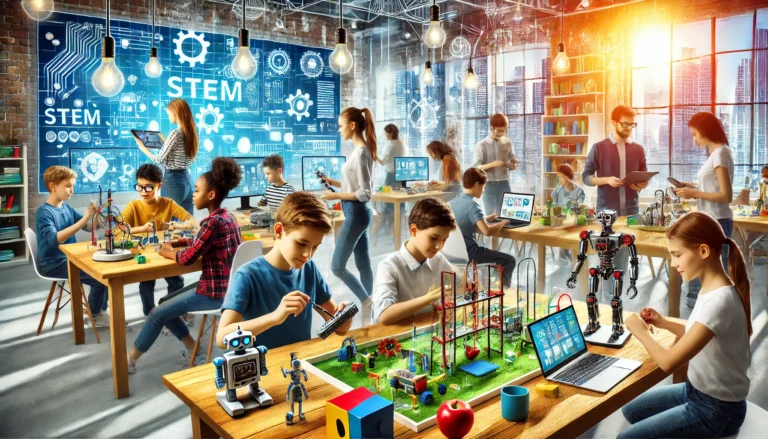
Artificial Intelligence (AI) is revolutionizing education by offering personalized learning experiences and automating time-consuming tasks like grading. With the potential to improve both teaching and learning, AI is reshaping how students engage with their studies and how educators manage classrooms. From tailored lessons to streamlined administrative processes, AI is making education more accessible, efficient, and adaptable than ever before.
1. Personalized Learning Through AI
AI is enabling a shift towards more personalized, student-centered education. By using algorithms and data analysis, AI systems can create customized learning paths for each student, taking into account their individual strengths, weaknesses, and preferences. Here’s how:
a. Adaptive Learning Systems
- AI-powered platforms can adjust the difficulty level of lessons based on how well a student is performing, providing extra support or advanced challenges when needed.
- These systems provide immediate feedback, helping students grasp concepts at their own pace.
b. Learning Style Adaptation
- AI can analyze how a student learns best (e.g., through visuals, text, or interactive activities) and adapt the content accordingly.
- It ensures students stay engaged and absorb material in ways that are most effective for them.
c. Data-Driven Insights
- AI collects and analyzes data from students’ performance and behavior to identify patterns and provide valuable insights to educators.
- Teachers can use this information to modify lesson plans or offer targeted support, improving learning outcomes.

2. Automating Grading Systems
Grading can be one of the most time-consuming tasks for educators, especially when it comes to large classes or detailed assignments. AI-powered grading systems are helping to alleviate this burden by automating much of the process.
a. Efficient and Accurate Grading
- AI can quickly assess multiple-choice, short-answer, and even essay-based assignments, providing consistent and unbiased grading.
- This frees up educators’ time to focus on more personalized student engagement and instruction.
b. Real-Time Feedback
- Automated grading allows students to receive instant feedback on their assignments, enabling them to understand their mistakes and improve more efficiently.
- It also supports a faster turnaround on grades, improving the learning experience for students.
c. Continuous Assessment
- AI can evaluate students on an ongoing basis, tracking their progress over time and offering real-time insights to both students and educators.
- This approach helps identify struggling students earlier and allows for timely interventions.
3. The Benefits of AI in Education
a. Accessibility
- AI-based learning tools are available to students anywhere with an internet connection, making education more accessible for those in remote or underserved areas.
- AI tools can also support students with disabilities by offering customizable learning materials, such as voice-to-text software or content in different formats (audio, visual, etc.).
b. Scalability
- AI can handle large amounts of data from a wide range of students, making it easier to scale learning programs across entire schools or even global institutions.
- It reduces the administrative burden and ensures that quality education can be delivered to a larger number of students.
c. Teacher Support
- With AI taking care of grading and administrative tasks, teachers have more time to focus on what matters most: teaching.
- AI also helps in identifying students who may need additional support, allowing educators to intervene early and provide personalized assistance.
4. Challenges and Considerations
a. Data Privacy and Security
- The use of AI in education requires the collection and analysis of student data, raising concerns about privacy and the security of sensitive information.
- Schools must ensure that AI tools comply with data protection regulations and prioritize student privacy.
b. Equity and Accessibility
- Not all students have access to the technology required for AI-driven learning, such as reliable internet or modern devices.
- Addressing the digital divide is crucial for ensuring AI-based education tools are available to all students, regardless of their background.
c. Teacher Training
- Teachers need proper training to effectively integrate AI tools into their classrooms.
- Ongoing professional development is essential to ensure educators understand how to make the best use of AI and adapt it to meet their students’ needs.

5. The Future of AI in Education
AI in education is still evolving, and its potential is vast. In the future, we may see even more sophisticated AI systems that can simulate personalized tutoring, conduct real-time language translations, and even provide emotional support for students.
- Learning Analytics: AI will enable more advanced tracking of student progress, helping educators make data-driven decisions to optimize teaching methods.
- AI Tutors: Virtual AI tutors could provide one-on-one support, guiding students through difficult concepts outside of regular class hours.
- Enhanced Collaboration: AI could help foster greater collaboration between students, allowing them to work together on projects in virtual environments with tools that enhance their learning experience.
Conclusion: Embracing the AI Revolution in Education
AI is transforming the educational landscape, offering tools that enhance personalization, efficiency, and accessibility. While there are challenges to overcome, the benefits are undeniable. By embracing AI, we can create a more adaptive, inclusive, and effective education system, preparing students for success in a rapidly changing world.






